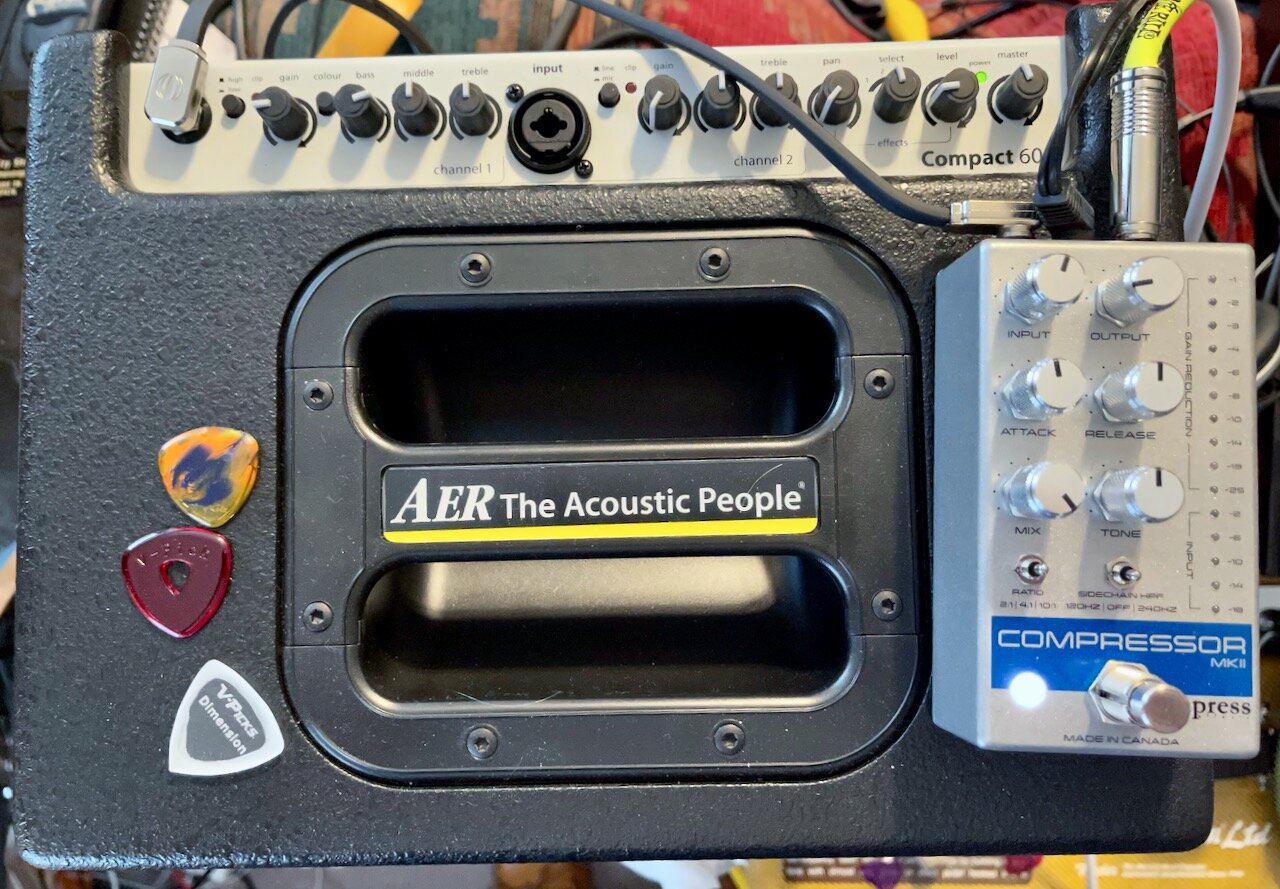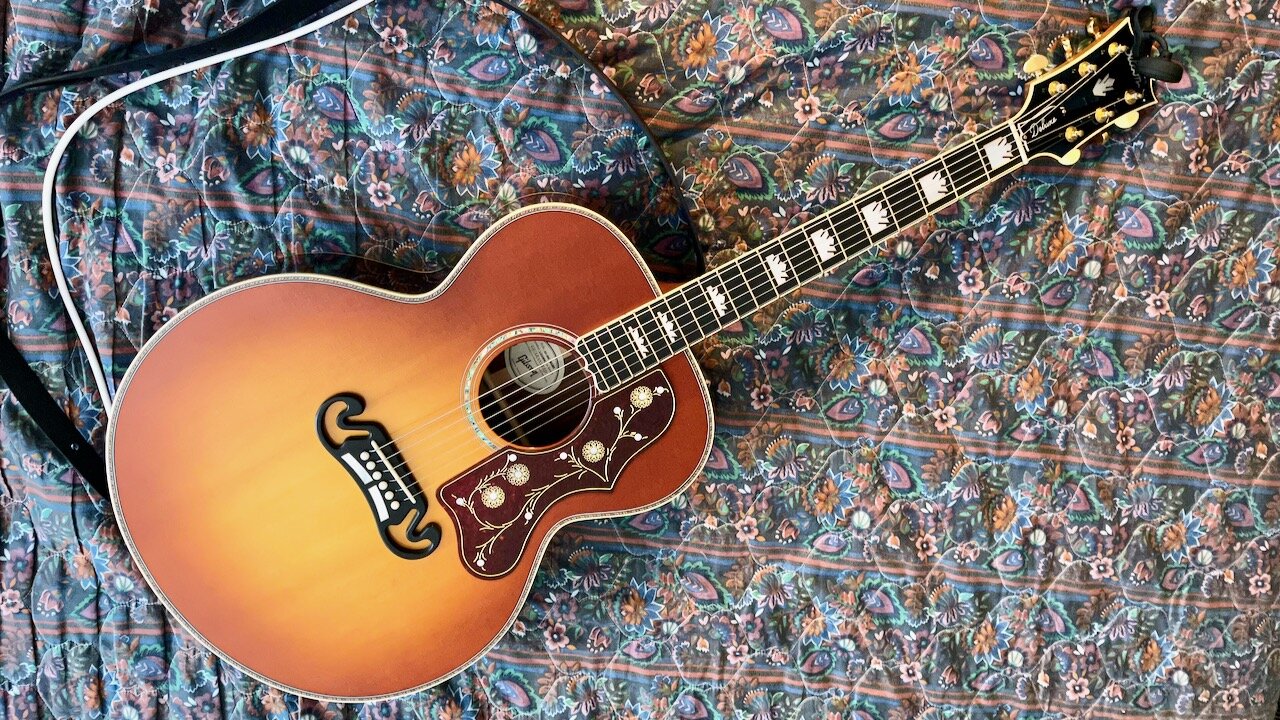Review : Empress Compressor Mk II
The Empress Compressor Mk II in use
Let me start off with wow!
As regular readers know, I am a serious compressor dork and have bought, returned and sold more than anyone else that I have ever met. This does not make me a hero in any way, merely emphasizes my love for great compressors and disdain for the rest.
For me, both as a player and recording engineer (at some level), compressors are not optional. I want to get all the tone that I can out of the amp and onto the disk. When recording live, I will often use a UA or Teletronix compressor plugin in Logic Pro X, but for capturing live play, I want the compressor in front of the amp and the signal going out to the interface via DI.
As you see in the opening photo, this is my general acoustic rig. An AER Compact 60 Tommy Emmanuel Signature amp and (now) the Empress Compressor Mk II between the guitar and the amp. I have used all kinds of different pedal compressors, mostly built into acoustic preamps like the excellent SansAmp Acoustic Rig. In this case though, I need the amp to do the amp job and still want the DI out of the amp to the recording interface.
My instrument for the exercise in question is the enormous Gibson SJ 200 Deluxe. This is the largest body acoustic that Gibson makes and is based on the proven Southern Jumbo design. This model has the spruce top but instead of maple sides and back as found in the regular SJ 200, the Deluxe model replaces the solid maple with solid rosewood. I own a Taylor Grand Orchestra spruce over maple, and I assure you that they deliver different tonal palettes.
The monster being tamed - Gibson SJ 200 Deluxe
Acoustically, the SJ-200 Deluxe is lovely in tone, but the factory installed pickup, which I believe to be an LR Baggs piezo is really quite horrible. I needed the preamp on the AER to bring back the bass response that the SJ body is known for, the factory pickup output being tinny and brittle. If one had played this guitar only plugged in, it would still be hanging on a peg in a guitar store. For the price of this instrument, Gibson should have gone with a better pickup rather than whatever the low bid was. As soon as my K&K Trinity kit arrives, whatever is in there is going to the dump. More on the K&K Trinity in another article.
As you all probably know by now, a compressor squeezes the dynamic range by a user defined amount, reducing the signal peaks and lifting the quietest parts. Too much compression sounds squished like you stuffed everything into a small box and this is the issue with most pedal compressors. They were built for electric guitars, have limited frequency response and focus on the squish. I dislike them intensely.
There are pedal compressors that are not squishy. The Diamond Compressors are excellent. So too the Origin Effects Cali76 that I have written about here and that lives on my Blackface Twin pedal board. I use the original Empress on my board for the Boogie Mk V and Silver Jubilee. I use a Strymon Compadre on my DI only rig. When I read that Empress had brought out a new version in a smaller box, and knowing that I wanted a compressor to use with the AER without replacing the AER preamp, I ordered this one up from Electric Mojo Guitars.
Mine is the silver version although it is also available in Blue Sparkle. I need to see things in dim light so went with the brighter background. It’s a very clean design. The compression ratios are fixed options at 2:1, 4:1 and 10:1 For my purposes, I find 4:1 great for acoustic guitars. If you want to put the compressor in a side chain, that option exists and provides two high pass filters as options.
Input controls the input signal level and there is a dedicated LED meter to help you get the level right. Output lets you control the output level if you need to do some level matching. You have the usual Attack and Release options, where Attack defines how fast the compressor engages and Release how long before the compressor lets go of the signal. Settings are subjective to the instrument and the user so feel free to play. The Tone knob is a general use tone circuit, and I don’t use, doing my frequency adjustments at the amp or in the DAW. Mix allows you to blend the compressed and uncompressed signal. This function is very important to me as it gives more control over what is happening to my signal.
I like that this is a stomp box for live work, but also like that the switch is silent and a soft press if I want to set it on top of the amp for hand actuation. The compression is very clean, never clicky or squishy, perfect for an acoustic instrument or any instrument played into a clean amp.
When you start to use overdrives or distortions they introduce their own compression and you may find at that point that you won’t use the compression from the Empress at the same time. Or you might, such is the joy of driving your own bus. You decide what you want things to sound like.
For the serious player or recordist, a compressor is a must have as far as I am concerned. There are some great ones out there, and a lot that I dislike. The Empress Compressor Mk II is one of the greats.
Until next time, peace.



